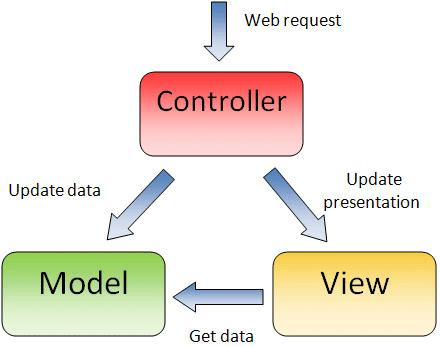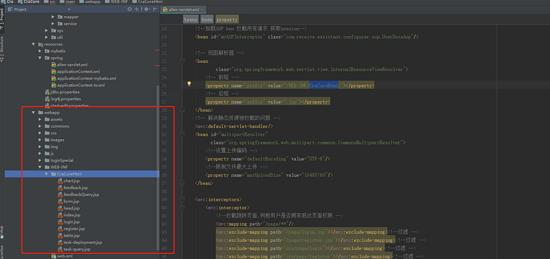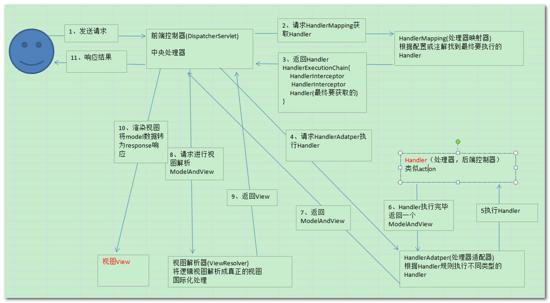spring mvc 常用注解详解

前言
现在主流的Web MVC框架除了Struts这个主力 外,其次就是Spring MVC了,因此这也是作为一名程序员需要掌握的主流框架,框架选择多了,应对多变的需求和业务时,可实行的方案自然就多了。不过要想灵活运用Spring MVC来应对大多数的Web开发,就必须要掌握它的配置及原理。
Spring mvc 介绍
Spring Web MVC是一种基于Java的实现了Web MVC设计模式的请求驱动类型的轻量级Web框架,即使用了MVC架构模式的思想,将web层进行职责解耦,基于请求驱动指的就是使用请求-响应模型,框架的目的就是帮助我们简化开发,Spring Web MVC也是要简化我们日常Web开发

image.png
spring mvc 常用注解详解
@Controller
在SpringMVC 中,控制器Controller 负责处理由DispatcherServlet 分发的请求,它把用户请求的数据经过业务处理层处理之后封装成一个Model ,然后再把该Model 返回给对应的View 进行展示。在SpringMVC 中提供了一个非常简便的定义Controller 的方法,你无需继承特定的类或实现特定的接口,只需使用@Controller 标记一个类是Controller ,然后使用@RequestMapping 等一些注解用以定义请求URL 请求和Controller 方法之间的映射,这样的Controller 就能被外界访问到。其标记在一个类上,使用它标记的类就是一个SpringMVC Controller 对象。分发处理器将会扫描使用了该注解的类的方法,并检测该方法是否使用@RequestMapping 注解。@Controller 只是定义了一个控制器类,而使用@RequestMapping 注解的方法才是真正处理请求的处理器。此外我们还需要将controller注册到spring里
@RequestMapping
RequestMapping是一个用来处理请求地址映射的注解,可用于类或方法上。用于类上,表示类中的所有响应请求的方法都是以该地址作为父路径,作用于方法上,表明该处理器的请求地址=父路径+方法上url+method,其拥有6个属性
1、 value, method;定义处理器访问的具体体质
value: 指定请求的实际地址,指定的地址可以是URI Template 模式;
method: 指定请求的method类型, GET、POST、PUT、DELETE等;
2、consumes,produces 定义处理器内容类型
consumes: 指定处理请求的提交内容类型(Content-Type),例如application/json, text/html;
produces: 指定返回的内容类型,仅当request请求头中的(Accept)类型中包含该指定类型才返回;
3、params,headers 定义处理器处理类型
params: 指定request中必须包含某些参数值,才让该方法处理!
headers: 指定request中必须包含某些指定的header值,才能让该方法处理请求。
@PathVariable
用于将请求URL中的模板变量映射到功能处理方法的参数上,即取出uri模板中的变量作为参数。如:
@Controller
public class TestController {
@RequestMapping(value="/user/{userId}/roles/{roleId}",method = RequestMethod.GET)
public String getLogin(@PathVariable("userId") String userId,
@PathVariable("roleId") String roleId){
System.out.println("取出请求路径携带的参数->User Id : " + userId);
System.out.println("取出请求路径携带的参数->Role Id : " + roleId);
return "hello";
}
}
@requestParam
@requestParam主要用于在SpringMVC后台控制层获取参数,类似一种是request.getParameter("name"),它有三个常用参数:defaultValue = "0", required = false, value = "isApp";defaultValue 表示设置默认值,required 铜过boolean设置是否是必须要传入的参数,value 值表示接受的传入的参数类型。
@ResponseBody
作用: 该注解用于将Controller的方法返回的对象,通过适当的HttpMessageConverter转换为指定格式后,写入到Response对象的body数据区。使用时机:返回的数据不是html标签的页面,而是其他某种格式的数据时(如json等)使用;
@RequestBody
该注解常用来处理Content-Type: 不是application/x-www-form-urlencoded编码的内容,例如application/json, application/xml等;它是通过使用HandlerAdapter 配置的HttpMessageConverters来解析post data body,然后绑定到相应的bean上的。
@RequestMapping(value = "/something", method = RequestMethod.PUT)
public void handle(@RequestBody String body, Writer writer) throws IOException {
writer.write(body);
}
spring mvc 拦截器配置
preHandle:预处理回调方法,返回值:true表示继续流程,false表示流程中断(如登录检查失败),不会继续续调用其他的拦截器或处理器,此时我们需要通过response来产生响应;
postHandle:后处理回调方法,实现处理器的后处理(但在渲染视图之前),此时我们可以通过modelAndView(模型和视图对象)对模型数据进行处理或对视图进行处理,modelAndView也可能为null。
afterCompletion:整个请求处理完毕回调方法,即在视图渲染完毕时回调,如性能监控中我们可以在此记录结束时间并输出消耗时间,还可以进行一些资源清理,类似于try-catch-finally中的finally,但仅调用处理器执行链中preHandle返回true的拦截器的afterCompletion。
public class Login implements HandlerInterceptor {
@Override
public void afterCompletion(HttpServletRequest httpRequest,
HttpServletResponse httpResponse, Object arg2, Exception arg3)
throws Exception {
}
@Override
public void postHandle(HttpServletRequest arg0, HttpServletResponse arg1,
Object arg2, ModelAndView arg3) throws Exception {
}
@Override
public boolean preHandle(HttpServletRequest request, HttpServletResponse response,
Object object) throws Exception {
/*HttpServletRequest httpRequest = (HttpServletRequest) request;
HttpServletResponse httpResponse = (HttpServletResponse) response;*/
String urlString = request.getRequestURI();
///olForum/forumList.html模拟登录页
if(urlString.endsWith("forumList.html")){
return true;
}
//请求的路径
String contextPath=request.getContextPath();
/*httpRequest.getRequestDispatcher("/olForum/forumList").forward(httpRequest, httpResponse);*/
/*response.sendRedirect(contextPath+"/olForum/forumList.html");*/
response.sendRedirect(contextPath + "/olForum/forumList.html?login=aaa");
return false;
/*httpResponse.sendRedirect(httpRequest.getContextPath()+"/olForum/forumList.html");
return;*/
}
}
<?xml version="1.0" encoding="UTF-8"?>
<beans xmlns="http://www.springframework.org/schema/beans"
xmlns:aop="http://www.springframework.org/schema/aop"
xmlns:context="http://www.springframework.org/schema/context"
xmlns:mvc="http://www.springframework.org/schema/mvc"
xmlns:tx="http://www.springframework.org/schema/tx"
xmlns:xsi="http://www.w3.org/2001/XMLSchema-instance"
xmlns:p="http://www.springframework.org/schema/p"
xsi:schemaLocation="http://www.springframework.org/schema/aop http://www.springframework.org/schema/aop/spring-aop.xsd
http://www.springframework.org/schema/beans http://www.springframework.org/schema/beans/spring-beans.xsd
http://www.springframework.org/schema/context http://www.springframework.org/schema/context/spring-context.xsd
http://www.springframework.org/schema/mvc http://www.springframework.org/schema/mvc/spring-mvc.xsd
http://www.springframework.org/schema/tx http://www.springframework.org/schema/tx/spring-tx.xsd">
<!-- 扫描controller(controller层注入) -->
<context:component-scan base-package="com.bybo.aca.web.controller"/>
<mvc:interceptors>
<!-- 使用bean定义一个Interceptor,直接定义在mvc:interceptors根下面的Interceptor将拦截所有的请求 -->
<!-- <bean class="com.bybo.aca.web.interceptor.Login"/> -->
<mvc:interceptor>
<!-- 进行拦截:/**表示拦截所有controller -->
<mvc:mapping path="/**" />
<!-- 不进行拦截 -->
<mvc:exclude-mapping path="/index.html"/>
<bean class="com.bybo.aca.web.interceptor.Login"/>
</mvc:interceptor>
</mvc:interceptors>
<bean id="viewResolver" class="org.springframework.web.servlet.view.InternalResourceViewResolver"
p:prefix="/WEB-INF/views/" p:suffix=".jsp"/>
</beans>
spring mvc 静态资源放问配置

image.png
<!-- 视图解析器 -->
<bean class="org.springframework.web.servlet.view.InternalResourceViewResolver"> <!-- 前缀 --> <property name="prefix" value="/WEB-INF/CraCoreHtml/"></property> <!-- 后缀 --> <property name="suffix" value=".jsp"></property> </bean> <!-- 解决静态资源被拦截的问题 --> <mvc:default-servlet-handler/>
spring mvc 文件上传
<!-- SpringMVC上传文件时,需要配置MultipartResolver处理器 --> <bean id="multipartResolver" class="org.springframework.web.multipart.commons.CommonsMultipartResolver"> <property name="defaultEncoding" value="UTF-8" /> <!-- 指定所上传文件的总大小,单位字节。注意maxUploadSize属性的限制不是针对单个文件,而是所有文件的容量之和 --> <property name="maxUploadSize" value="10240000" /> </bean>
前端
<form action="/shop/auth/photoUpload" method="post" enctype="multipart/form-data"> 选择文件:<input type="file" name="file"> <input type="submit" value="上传"> </form>
后端
@RequestMapping(value = "taskUpload", produces = "text/html;charset=UTF-8", method = RequestMethod.POST)
public ResponseEntity<String> taskUpload(@Validated Task task, HttpServletRequest request) throws Exception {
if (StringUtils.isNotBlank(task.getAnnouncement())) {
String type = task.getType();
return Optional.ofNullable(taskService.saveSelective(task))
.filter((value) -> value > 0)
.map(result -> new ResponseEntity<>(type + "公告发布成功", HttpStatus.OK))
.orElse(ResponseEntity.status(HttpStatus.NOT_FOUND).body("公告发布失败"));
}
File newFile = null;
try {
CommonsMultipartResolver multipartResolver = new CommonsMultipartResolver(
request.getSession().getServletContext());
if (request instanceof MultipartHttpServletRequest) {
// 将request变成多部分request
MultipartHttpServletRequest multiRequest = (MultipartHttpServletRequest) request;
Iterator<String> iter = multiRequest.getFileNames();
// 检查form中是否有enctype="multipart/form-data"
if (multipartResolver.isMultipart(request) && iter.hasNext()) {
// 获取multiRequest 中所有的文件名
while (iter.hasNext()) {
List<MultipartFile> fileRows = multiRequest.getFiles(iter.next().toString());
if (fileRows != null && fileRows.size() != 0) {
for (MultipartFile file : fileRows) {
if (file != null && !file.isEmpty()) {
// 文件新路径
String filePath = getFilePath(request, file.getOriginalFilename());
newFile = new File(filePath);
// 写文件到磁盘
file.transferTo(newFile);
String type = task.getType();
if (newFile.exists()) {
CraFile craFile = new CraFile();
craFile.setFilePath(filePath);
craFile.setFileType(task.getType());
Integer integer = fileService.saveSelective(craFile);
if (integer > 0) {
task.setFileId(craFile.getId());
return Optional.ofNullable(taskService.saveSelective(task))
.filter((value) -> value > 0)
.map(result -> new ResponseEntity<>(type + "上传成功", HttpStatus.OK))
.orElse(ResponseEntity.status(HttpStatus.NOT_FOUND).body("上传失败"));
}
} else {
return ResponseEntity.status(HttpStatus.NOT_FOUND).body("上传失败");
}
}else {
return ResponseEntity.status(HttpStatus.INTERNAL_SERVER_ERROR).body("未能检测到上传文件");
}
}
}
}
}
}
} catch (Exception ex) {
ex.printStackTrace();
if (newFile != null) {
if (newFile.exists()) {
newFile.delete();
}
}
return ResponseEntity.status(HttpStatus.NOT_FOUND).body("上传失败");
}
return ResponseEntity.status(HttpStatus.INTERNAL_SERVER_ERROR).body("服务器繁忙");
}
spring mvc 工作流程详解

image.png
1、 用户发送请求至前端控制器DispatcherServlet。
2、 DispatcherServlet收到请求调用HandlerMapping处理器映射器。
3、 处理器映射器找到具体的处理器(可以根据xml配置、注解进行查找),生成处理器对象及处理器拦截器(如果有则生成)一并返回给DispatcherServlet。
4、 DispatcherServlet调用HandlerAdapter处理器适配器。
5、 HandlerAdapter经过适配调用具体的处理器(Controller,也叫后端控制器)。
6、 Controller执行完成返回ModelAndView。
7、 HandlerAdapter将controller执行结果ModelAndView返回给DispatcherServlet。
8、 DispatcherServlet将ModelAndView传给ViewReslover视图解析器。
9、 ViewReslover解析后返回具体View。
10、DispatcherServlet根据View进行渲染视图(即将模型数据填充至视图中)。
11、 DispatcherServlet响应用户。
关注作者,我会不定期在思否分享Java,Spring,MyBatis,Netty源码分析,高并发、高性能、分布式、微服务架构的原理,JVM性能优化、分布式架构,BATJ面试 等资料...
- 本文标签: Action 高并发 ip IDE HTML SpringMVC entity Property 分布式 并发 servlet 数据 程序员 list src 处理器 id 微服务 UI App value schema message AOP 适配器 源码 配置 CEO XML final ACE IO JVM 服务器 map 设计模式 json 开发 http ORM session web cat 时间 URLs 参数 ask bean 性能优化 java js 需求 Select mybatis core Service 模型 spring https Netty 解析 文件上传
- 版权声明: 本文为互联网转载文章,出处已在文章中说明(部分除外)。如果侵权,请联系本站长删除,谢谢。
- 本文海报: 生成海报一 生成海报二











![[HBLOG]公众号](http://www.liuhaihua.cn/img/qrcode_gzh.jpg)

